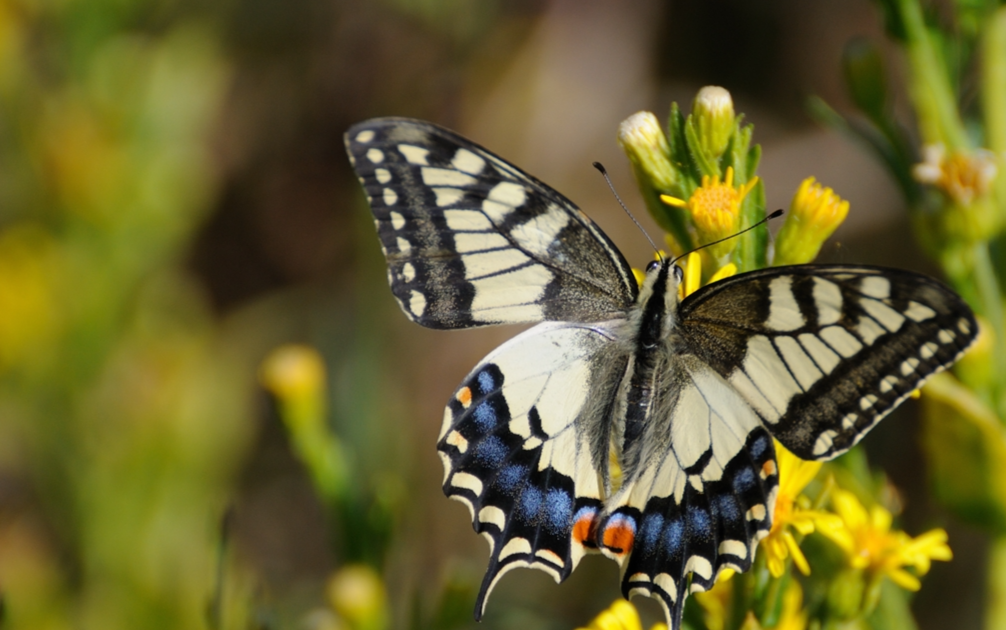A study, carried out by the University of Bristol in partnership with the universities of Edinburgh and Reading and the Royal Horticultural Society, published in the Journal of Ecology, measured for the first time the amount of nectar produced in urban areas, discovering that private gardens are the major source of livelihood for pollinating insects, including bees.
Floral resources (nectar and pollen) appear to be essential for the survival of pollinators, but have undergone a drastic decrease in rural areas, mainly due to the change in land use. Given the worrying decrease in pollinators that has been occurring in recent decades, it is of fundamental importance to know in greater detail every aspect of the life of these animals; it is particularly interesting to obtain knowledge about the ways in which these organisms find food resources.
Common Blue. Photo by Andrea Senese.

Although nectar resources have already been measured in rural environments, there was a lack of equivalent data for urban areas.
This particular research stems from the need to measure the supply of nectar in cities, so as to be able to provide important data for the protection of the urban biodiversity.
By combining data on flower abundance and nectar production from 536 Angiosperm taxa, the team of researchers quantified the nectar supply of urban areas, farmlands and nature reserves in the UK, comparing landscape types and assessing the “spatial distribution” of the nectar.
Old World Swallowtail. Photo by Andrea Senese.

The results show that, on average, three gardens generate around a teaspoon of nutrients useful to pollinators every day. This apparently small quantity in reality, when compared to the size of an Insect, is equivalent to more than a ton for an adult man, and is therefore able to support, for example, the energy needs of thousands of bees.
Western Honey Bee. Photo by Andrea Senese.

According to the main author of the study – the ecologist Nicholas Tew – the result of the research far exceeded all expectations, highlighting the fundamental role that flower boxes, balconies and private gardens play in the maintenance of entomological communities and in the promotion of urban biodiversity in all over the country.
Eurasian Bee Beetle. Photo by Giuseppe De Riso.

As for urban centers, the study looked at nectar production in four major UK cities: Bristol, Edinburgh, Leeds and Reading. The production of nectar was measured in nearly 200 plant species, through the extraction of nectar from over 3000 individual flowers. The sugar concentration of the nectar was quantified with a refractometer, a device that measures how much light refracts as it passes through a solution.
The results of the research reveal a greater diversification of the supply of nectar in city centers, coming from a greater number of plant species than rural landscapes and natural environments. Offer which is mainly supported by private gardens.
Geranium Bronze. Photo by Andrea Senese.

In urban areas, the supply of nectar has a more diversified origin due to the presence of non-native ornamental flowering plants combined with native, medicinal and spontaneous species.
The study confirms the important role played by floriculture enthusiasts in the conservation of pollinators, since the absence of ornamental plants would result in a substantial reduction in the trophic supply for the city’s entomofauna. It therefore appears essential that residential settlements include gardens and that these are designed in such a way as to be as suitable as possible for the ecology of pollinators.
Scarce Swallowtail. Photo by Andrea Senese.

The handbook of the “biodiverse garden” provides for the planting of species capable of producing flowers rich in nectar; the presence of flowering plants over as long as possible (from early spring to late autumn); an infrequent mowing of the lawns, so as to favor the flourishing of spontaneous species such as dandelions, clovers, daisies and other angiosperms; a very limited use of pesticides, harmful to the life of pollinators, and of works such as pavements and artificial lawns.
European Rose Chafer. Photo by Andrea Senese.

As we often say, city parks and gardens represent real biodiversity hotspots in an urban environment. But even a single tree can host an interesting community of inhabitants, it is good to see gardens, flower beds and hedges not as separate entities, but as a dense network of ecological niches and food resources.
This network constitutes a fundamental element for wild plants and animals at all times of the year, including, precisely, pollinating Insects, an essential community for the survival of ecosystems and for our existence on planet Earth.
Old World Swallowtail. Photo by Andrea Senese.

The results of this scientific research are valid for England, a country that has always been famous for the attention paid by its inhabitants to the art of gardening. It would be interesting to know what the contribution made by our urban centers to the sustenance of pollinators could be. The impression is that, unfortunately, the many balconies left empty (or worse turned into illegal verandas) or the many outdoor areas where the detestable synthetic grass is favored on a lawn, can lead to much less exciting results.
Nothing unsolvable but we must stubbornly continue on the path of raising awareness among citizens and institutions by making use of studies like this one that provide the scientific evidence that must act as a backbone in the battle of those who ask for greener cities.